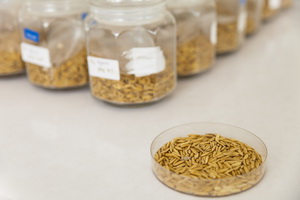
Early Leaf Senecence and Salt Stress Response Gene Found in Rice
May 2, 2018| |
 Early leaf senescence can cause negative effects on rice yield and its regulation is relatively unknown. The team of Dong-Dong Zeng from Zhejiang University in China isolated and studied the bilateral blade senescence 1 (bbs1) rice (Oryza sativa), an early leaf senescence mutant with a premature senescence phenotype that occurs at the leaf margins, in hopes of understanding the mechanism of early leaf senescence.
Early leaf senescence can cause negative effects on rice yield and its regulation is relatively unknown. The team of Dong-Dong Zeng from Zhejiang University in China isolated and studied the bilateral blade senescence 1 (bbs1) rice (Oryza sativa), an early leaf senescence mutant with a premature senescence phenotype that occurs at the leaf margins, in hopes of understanding the mechanism of early leaf senescence.
The mutant showed premature leaf senescence beginning at the tillering stage and exhibited severe symptoms at the late grain-filling stage. The mutant also showed accelerated dark-induced leaf senescence. The OsBBS1 gene of the bbs1 mutant was analyzed and was found to have an insertion in its first exon. This gene encodes a receptor-like cytoplasmic kinase.
OsBBS1-knockout plants generated via CRISPR-Cas9 exhibited similar early leaf senescence phenotypes as did the bbs1 mutant. The OsBBS1 gene is expressed in all detected tissues and was predominantly expressed in the main vein region of mature leaves. The expression of OsBBS1 could be greatly induced by salt stress, and the bbs1 mutant exhibited hypersensitivity to salt stress.
This is the first identification of OsBBS1 being involved in leaf senescence and playing critical roles in the salt stress response in rice.
For more information, read the article in Plant Cell Reports.
| |
Biotech Updates is a weekly newsletter of ISAAA, a not-for-profit organization. It is distributed for free to over 22,000 subscribers worldwide to inform them about the key developments in biosciences, especially in biotechnology. Your support will help us in our mission to feed the world with knowledge. You can help by donating as little as $10.
-
See more articles:
-
News from Around the World
- Borlaug Global Rust Initiative Honors Women in Wheat Research
- WEMA Maize Shows Promising Resistance to Fall Armyworm in Mozambique
- Researchers Move Toward Better Understanding of Deadly Citrus Disease
- Cotton Research Goes to Space
- Research Unlocks Rice Gene Diversity for Food Security
- Plant Scientists Boost Malaria Drug Yield in Plant
- Why Grass Cereals Are More Drought-tolerant Than Other Plants
- Europe's Current Approach to Food, Agriculture, and the Environment Not Sustainable, say European National Science Academies
-
Research Highlights
- SlAGL6 Gene is Key to Parthenocarpy in Tomato
- PcWRKY33 Gene from Japanese Knotweed Reduces Salt Tolerance in Transgenic Arabidopsis
- Gene from Wild Peanut Enhances Biotic and Abiotic Resistance in Tobacco
-
Beyond Crop Biotech
- The Effect of Single Metal Nanoparticles on Transformation Efficiency of Soybean
- FDA Approves Application for AquaBounty Salmon Facility in Indiana, USA
-
Announcements
- World Biotechnology Conference
-
Plant
- Wageningen University & Research Releases Booklet on New Plant Breeding Techniques
- CRISPR-Knockout of OsFAD2-1 Gene Improves Rice Bran Oil Health Benefits
- Japanese Researchers Establish New Cas9 Variant
- Early Leaf Senecence and Salt Stress Response Gene Found in Rice
-
Read the latest: - Biotech Updates (October 22, 2025)
- Gene Editing Supplement (October 29, 2025)
- Gene Drive Supplement (February 22, 2023)
-
Subscribe to BU: - Share
- Tweet
